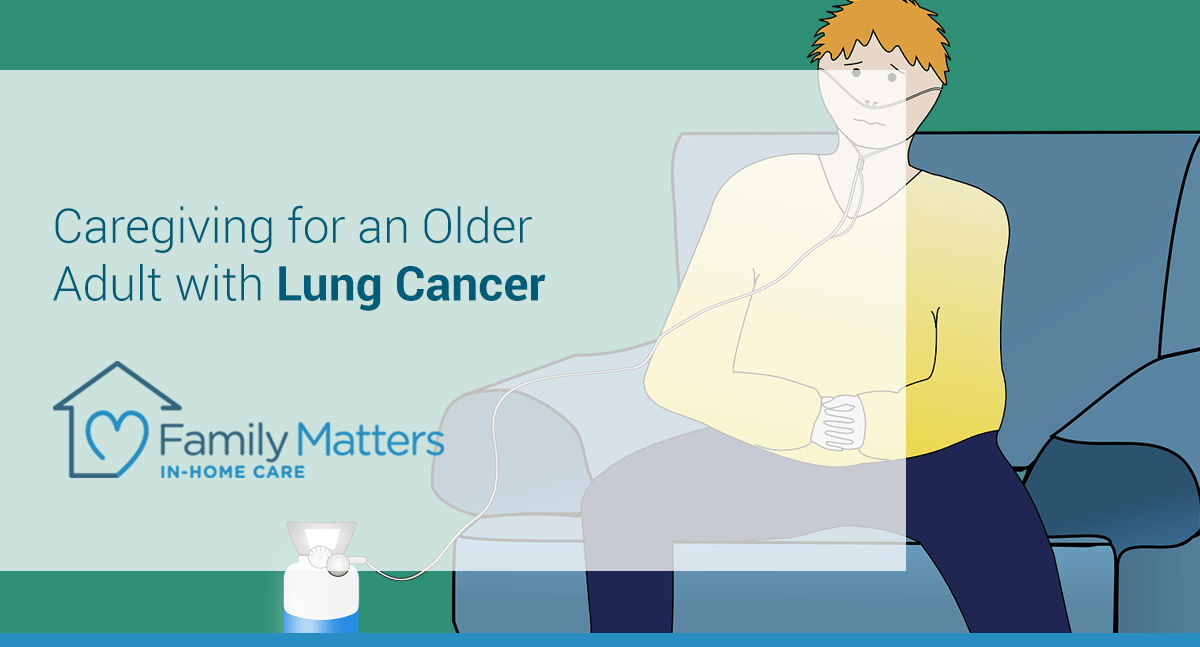
Caregiving for an Older Adult with Lung Cancer
For many years, a diagnosis of lung cancer cast a shadow of doom and helplessness over the patient and their families. However, due to the development of groundbreaking treatments and the birth of many new drugs during the past few decades, recovery is becoming more possible every day.
Many of the protocols take time and require lengthy treatments and drug therapies often administered on an outpatient basis. This situation requires the services of a home caregiver, a role that can be filled by a family member, friend or professional. The job requires far more than drug administration and assisting in person hygiene and frequently lasts for months or in some cases, years.
Cancer Knowledge
A caregiver should know as much as possible about the type of cancer their patient is battling so they can intelligently discuss the symptoms and treatments with the patient and their families. The three major categories of lung cancer are Non-Small Cell Lung Cancer, Small Cell Lung Cancer, and Lung Carcinoid Tumor and each has specifics caregivers should be knowledgeable of.
Non-Small Cell Lung Cancer accounts for around 85 percent of all lung cancer cases. Treatments vary depending on cancer subtypes and are administered independently or as part of a physician dictated regimen that includes several healing options. Surgery, immunotherapy, radiation, chemotherapy and radiofrequency ablation (RFA) are all common treatments for Non-Small Cell Lung Cancer.
Small Cell Lung Cancer comprises between 15 and 20% of lung cancer diagnoses. Also referred to as oat cell cancer, it aggressively grows and can rapidly invade other areas of the body. Surgery, chemotherapy and radiation therapy are popular treatment options.
The third type of lung cancer, Lung Carcinoid Tumors, is quite rare, making up less than 5% of lung cancer cases. The majority of these tumors rarely spread and usually develop at very low rates of speed.
Emotional Support
The most significant part of caring for a lung cancer patient is arguably strong emotional support. This entails much more than an ‘Atta boy’ or ‘Atta girl’ comment every day or so. Any type of cancer diagnosis is typically devastating, regardless of how many positive stats your physician recites or how many people say they’re praying for you. Older cancer victims fear what they know as much as the unknown and have frequently seen spouses, friends or other family members battle the disease. Both the victories and losses weigh heavily on their hearts and minds, as well as how well they can handle the often brutal treatments. The kind support, positive attitude and ability to listen and not just hear are vitally important traits for a caregiver.
Appointments and Meetings
When family members and friends are unable to accompany older cancer patients to examinations and informational meetings with health care professionals, caregivers are responsible for the job. Besides effectively scheduling and promptly arriving for appointments, caregivers typically take detailed notes of physician comments, conclusions and recommendations. The cancer patient is usually too tense and beleaguered to pay close attention to the details of communications, so the accuracy of the notes is imperative. If cancer patients are meeting with several medical professionals, they also depend on their caregiver to keep appointments efficiently scheduled to avoid stress and count on them to arrange reliable, comfortable transportation.
Food and Nutrition
Keeping cancer patients healthy is considered by many to be the most important job of a caregiver. Even if emotional support is strong and impeccable, a well planned diet is crucial for a cancer patient to maintain high energy levels, endure the frequently grueling side effects of various treatments, put up with painful symptoms of the disease, and prevent weight loss. This aspect of caregiving requires much more than planning and preparing tasty, balanced and nutritious meals. Treatments and drugs frequently interfere with food ingestion. Common symptoms that can be obstacles to eating include vomiting, lack of appetite, trouble with swallowing, pain in the gums and mouth, upset stomach, and problems with food tasting odd as a side effect of certain drugs.
The Importance of Follow-up Care
Every cancer patient reacts differently to the disease, from mental and psychological reactions to physical side effects. Their primary physician typically keeps close tabs on side effects but since the caregiver spends the majority of time with the patient, their care and observations are of utmost importance to the patient’s recovery. Besides asking a myriad of questions on a daily basis to determine if a recurrence is indicated to tracking side effects and keeping the oncologist well informed, the caregiver serves as friend and advocate. They must be supportive, encouraging and positive to increase the patient’s chances of recovery and keep them from dwelling on any negative thoughts. The caregiver’s role entails much more than care; they often must play the role of spouse, child, best friend and inspirational companion to adequately fulfill their position.
If you or your family member is considering in-home care as part of a plan to age in place, contact Family Matters In-Home Care today for a free consultation. Our team is dedicated to supporting your family and helping older adults enjoy life in the comfort of their own home for as long as possible.
Some of the services offered by Family Matter In-Home Care include: Alzheimer’s & Dementia Care, Bed & Wheelchair Transfer Assistance, Companionship, Housekeeping & Meal Preparation, Personal Care, Recovery Care, and Transportation.
